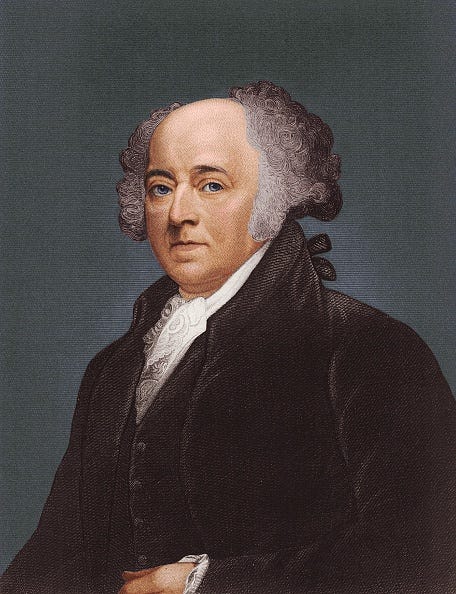TWA for Saturday, March 4, 2017
“To David, About His Education” by Howard Nemerov from The Collected Poems of Howard Nemerov. © University of Chicago Press, 1972.
ORIGINAL TEXT AND AUDIO - 2017
John Adams was inaugurated on this date in 1797. He became the second president of the United States, succeeding George Washington in the first peaceful transfer of power between elected officials in modern times. His rival for the office had been Thomas Jefferson, and because Jefferson had received the second highest number of electoral votes, the Electoral College named him vice president.
The ceremony took place on a sunny day at Philadelphia's Congress Hall. George Washington entered the packed Chamber of the House of Representatives to applause, followed by the vice president, Thomas Jefferson. Adams was last, dressed in a suit of gray broadcloth. He must have looked frumpy next to the tall and elegant Jefferson, who was clad in a long blue frock coat, and the stately Washington, dressed in black velvet.
"A solemn scene it was indeed," Adams later wrote. "Methought I heard [Washington] think, 'Ay! I am fairly out and you are fairly in! See which of us will be the happiest!'"
Franklin Delano Roosevelt was also inaugurated on this date, in 1933. By the time of his inauguration, the country had been mired in the Great Depression for more than three years. Roosevelt won in a landslide over Republican incumbent Herbert Hoover.
Most Americans didn't know the extent to which Roosevelt's paralytic illness had affected him, and he took great pains to keep it that way. In order for him to ascend the steps to the podium to take the oath of office, an elaborate series of wheelchair-accessible ramps was constructed and hidden behind barriers. He walked the last few yards leaning heavily on the arm of his son James, and he made it look easy even though it took great strength.
His inaugural address included the famous phrase "The only thing we have to fear is fear itself."
It's the birthday of Khaled Hosseini, born in Kabul (1965), author of the runaway best-selling novel The Kite Runner (2003), which has sold more than 12 million copies around the world.
He's the son of a diplomat, and his affluent family immigrated to the United States around the time of the Soviet invasion of Afghanistan, receiving political asylum as members of Afghanistan's government were being executed. They landed in San Jose, California, when Khaled was 12 with nearly nothing.
His diplomat father found work as a driving instructor in San Jose, and the family was forced to go on welfare. Khaled deferred his childhood dream of being a writer, feeling like he had to have a career that guaranteed a healthy income. So he went to medical school, made it through his residency, and had settled into a job as an internist when he began to think about writing again. He got up at 5 every morning so he could write for two hours before he went to the hospital. He wrote about his memories of Afghanistan, which were all good; they'd made it out of the country just before the Soviet invasion. He wrote a story about a friendship between an eight-year-old boy, the son of an Afghan diplomat, and one of the family's servants, an illiterate man from an ethnic minority group. The young prosperous son teaches the servant to read and write, and the servant teaches the child to fly kites.
When the book was all written and in the publisher's hands, he took a trip back to Kabul, for the first time in 27 years. When he'd left, it was a thriving affluent cosmopolitan city, but it had since spent decades in war. He knew it would be bad, but what he found was even worse than he expected. He walked the streets of his old hometown, now ravaged by war and with burqa-clad women and children all over the streets begging for money, people paralyzed by shrapnel, prevailing destitution and despair. He said, "I felt like a tourist in my own country."
He said that because his first book had been so phenomenally successful and expectations were so high, with a book contract and anxious publishers and booksellers, he had a bit of a hard time getting started on the writing of his second book. He was plagued by self-doubt about his literary capabilities and whether he could measure up to his debut success. He said that he has "this almost pathological fear of boring the reader." But eventually he found his way into the rhythm of the story, and into the inner lives of his characters. His second novel is a more ambitious book then his first, with lots of main characters, not at all autobiographical, multigenerational, and told from alternating points of view of two female narrators, their thoughts intertwined with a historical narrative of Afghanistan's past three decades. The women weren't based on anyone he knew, exactly, though were inspired by stories of people he'd encountered on his trip to Kabul. To get into his protagonists' mindset, he even tried on a burqa when no one was around, "just to see what it felt like." He said, "It steals your breath away. It's really hard to get used to."
A Thousand Splendid Suns, the story narrated by Afghani women Mariam and Laila, was published in mid-2007. The book was also hugely successful and was Britain's best-selling book in 2008. The title is an English translation from a 17th-century poem in Farsi; the Persian poet had written verses describing the splendor he'd experienced upon journeying to Kabul.
Hosseini’s latest novel, And the Mountains Echoed, came out in 2013.
Be well, do good work, and keep in touch.®
RELEASE WEEK - March 7th That Time of Year: A Minnesota Life (slightly revised) Softcover





